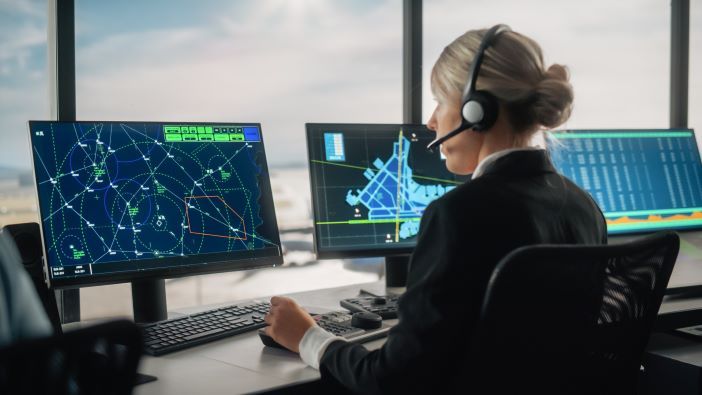If you’ve downloaded a flight radar app, you may have been astonished at the sheer number of aircraft criss-crossing the country. Zooming in on major airports such as Heathrow or JFK, all you can see is a vast pile of teeny planes all seemingly jostling to get on or off the runway. It appears to be completely chaotic, but every single aircraft is on a precisely dictated flight path. It i8s the work of air traffic controllers to create untroubled journeys and safe landings.
The aim of air traffic control is to move aircraft safely and efficiently through the airspace system, to maintain communication with the pilots, and to ensure compliance with aviation protocols. In the UK alone, around 7,000 aircraft traverse the country’s skies every day, and air traffic control services handle 2.5 million flights and 250 million passengers per year on commercial, leisure, cargo and military flights.
It is arguably one of the most responsible jobs anyone can undertake, with passenger safety depending on each decision. To become an air traffic controller (ATCo) you need to have good concentration, excellent verbal communication, problem-solving and decision-making skills, and the ability to pay attention to detail and work well under pressure.
The route to becoming an ATCo involves rigorous study; trainees begin by spending a year at a specialist college learning about the theories and practicalities of the job. Modules include air navigation law, air safety management and weather studies, as well as the complex rules and regulations of air traffic control. Having completed these modules, trainees can then specialise as one of three types of ATCo:
- Area controllers are based at a regional control centre and track and guide aircraft flying at high altitudes through their specific area.
- Approach controllers give instructions to aircraft which have just taken off and manage them on their approach to an airport.
- Aerodrome controllers work from an airport control tower, guiding pilots to their allocated stand and runway and giving take-off and landing clearance.
There are two types of airspace: controlled and uncontrolled. Surprisingly, the majority is uncontrolled and is used by recreational pilots and also some military flights; it’s up to the pilots to avoid collisions. Air traffic control services are provided in controlled airspace using radar and other surveillance systems to minimise delays and to keep aircraft at a safe distance from each other.
Before take-off, a flight plan for each aircraft is filed with air traffic control so that every ATCo who oversees the flight knows the route and details of the flight. At this stage the pilot will be communicating with an ATCo in the airport control tower, who is responsible for it at this stage and who will give the pilot permission to take off. When an aircraft takes off it follows a SID (Standard Instrument Departure) route. This route takes into consideration airspace management, noise abatement rules and obstacle avoidance.
As soon as the aeroplane has taken off, another ATCo takes over, usually from a control centre, who will track its journey through the airspace. Each ATCo has their own airspace, and when the aircraft leaves it, a handover is co-ordinated with the ATCo in charge of the next sector. If for any reason during the flight an aircraft has to deviate from its planned flight path (perhaps due to weather conditions), the ATCo in charge will manage the route directly, a process which is known as vectoring.
During the descent, the aircraft joins a STAR (Standard Terminal Arrival Route), which manages all arrivals with maximum efficiency. ATCos are responsible for maintaining communication with the pilots at all times, and for providing essential information such as altitude changes, speed adjustments, congestion over an airport, and anything else that could jeopardise a safe landing. Air traffic control operates 24 hours a day, every day of the year; there is never a time when controlled airspace is unmonitored.
In the event of an aviation emergency, the role of the ATCo is critical, providing assistance, direction and the co-ordination of contingency plans and other necessary responses. They help pilots with emergency procedures, set up route plans for emergency landings, organise the diversion of flights to other airports and keep the communication channels open. They may need to supply details such as passenger medical issues, aircraft mechanical failure, the amount of fuel remaining if an aircraft has to be diverted further than the initial route plan, as well as organising any response on the ground such as fire engines or ambulances.
Working in air traffic control is a highly specialised career with extensive training and considerable responsibility. Regular breaks are carefully scheduled throughout a shift in order to ensure that concentration remains optimal; an essential part of a job where lives can be at stake.
It is due to the skills and aptitude of the ATCos that, unlike the road networks, the highways of the sky stay uncongested and as safe as possible. So, as you taxi down the runway and prepare for take off on your next flight, you can be confident that the ATCos will be guiding your plane through each and every air mile.
About the author
Jim Scott is the founder and MD of Artemis Aerospace. Artemis Aerospace offers component solutions for the aviation sector. Established in 1999, its services include component supplies, component repairs, lessor support, flight simulation hardware support, consignment stock management and global aircraft logistics.





